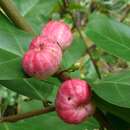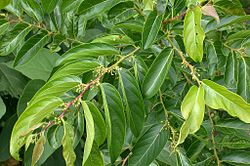pt-BR
nomes no trilho de navegação


Qloxidion (lat. Glochidion) - südləyənkimilər fəsiləsinə aid bitki cinsi.
Qloxidion (lat. Glochidion) - südləyənkimilər fəsiləsinə aid bitki cinsi.
Glochidion je rod cvjetnica iz porodice Phyllanthaceae, u Australiji poznatih pod nazivom sirasto drvo ili dugmasto drvo i listocvjetna stabla. Sastoji se od oko 300 vrsta,[1] rasprostranjenih od Madagaskara do Pacifičkih otoka. Vrstama ovog roda hrane se larve nekih vrsta Lepidoptera, uključujući Aenetus eximia i Endoclita damor. Ljudi Nikobarezi svjedočili su o ljekovitim svojstvima koja su pronađena u G. kalokarpum, rekavši da su njegova kora i sjeme najdjelotvorniji u liječenju trbušnih poremećaja povezanih sa amebijazom.[2]
Nekompletan listing:
Glochidion je rod cvjetnica iz porodice Phyllanthaceae, u Australiji poznatih pod nazivom sirasto drvo ili dugmasto drvo i listocvjetna stabla. Sastoji se od oko 300 vrsta, rasprostranjenih od Madagaskara do Pacifičkih otoka. Vrstama ovog roda hrane se larve nekih vrsta Lepidoptera, uključujući Aenetus eximia i Endoclita damor. Ljudi Nikobarezi svjedočili su o ljekovitim svojstvima koja su pronađena u G. kalokarpum, rekavši da su njegova kora i sjeme najdjelotvorniji u liječenju trbušnih poremećaja povezanih sa amebijazom.
Glochidion is a genus of flowering plants, of the family Phyllanthaceae, known as cheese trees or buttonwood in Australia, and leafflower trees in the scientific literature. It comprises about 300 species,[2] distributed from Madagascar to the Pacific Islands. Glochidion species are used as food plants by the larvae of some Lepidoptera species including Aenetus eximia and Endoclita damor.[3] The Nicobarese people have attested to the medicinal properties found in G. calocarpum, saying that its bark and seed are most effective in curing abdominal disorders associated with amoebiasis.[4]
Glochidion are of note in the fields of pollination biology and coevolution because they have a specialized mutualism with moths in the genus Epicephala (leafflower moths), in which the moths actively pollinate the flowers—thereby ensuring that the tree may produce viable seeds—but also lay eggs in the flowers' ovaries, where their larvae consume a subset of the developing seeds as nourishment.[5][6][7] Other species of Epicephala are pollinators, and in some cases, non-pollinating seed predators, of certain species of plants in the genera Phyllanthus[8][9] and Breynia,[10][11] both closely related to Glochidion.[12] This relationship is similar to those between figs and fig wasps and yuccas and yucca moths.
Although the genus Glochidion is native only to the Old World, the East Asian species Glochidion puberum has become naturalized at several locations in the U.S. state of Alabama.[13][14]
In a 2006 revision of the Phyllanthaceae, it was recommended that Glochidion be subsumed in Phyllanthus.[15] New combinations in Phyllanthus have been published for Madagascar[16] and the Pacific Islands,[17] but most remain to be published.
An incomplete listing:
Glochidion is a genus of flowering plants, of the family Phyllanthaceae, known as cheese trees or buttonwood in Australia, and leafflower trees in the scientific literature. It comprises about 300 species, distributed from Madagascar to the Pacific Islands. Glochidion species are used as food plants by the larvae of some Lepidoptera species including Aenetus eximia and Endoclita damor. The Nicobarese people have attested to the medicinal properties found in G. calocarpum, saying that its bark and seed are most effective in curing abdominal disorders associated with amoebiasis.
Glochidion are of note in the fields of pollination biology and coevolution because they have a specialized mutualism with moths in the genus Epicephala (leafflower moths), in which the moths actively pollinate the flowers—thereby ensuring that the tree may produce viable seeds—but also lay eggs in the flowers' ovaries, where their larvae consume a subset of the developing seeds as nourishment. Other species of Epicephala are pollinators, and in some cases, non-pollinating seed predators, of certain species of plants in the genera Phyllanthus and Breynia, both closely related to Glochidion. This relationship is similar to those between figs and fig wasps and yuccas and yucca moths.
Although the genus Glochidion is native only to the Old World, the East Asian species Glochidion puberum has become naturalized at several locations in the U.S. state of Alabama.
In a 2006 revision of the Phyllanthaceae, it was recommended that Glochidion be subsumed in Phyllanthus. New combinations in Phyllanthus have been published for Madagascar and the Pacific Islands, but most remain to be published.
Glochidion es un género de plantas con flores perteneciente a la familia Phyllanthaceae. Consiste en unas 300 especies que se distribuyen desde Madagascar a las islas del Pacífico.
etc.
Glochidion es un género de plantas con flores perteneciente a la familia Phyllanthaceae. Consiste en unas 300 especies que se distribuyen desde Madagascar a las islas del Pacífico.
Glochidion est un genre de plante de la famille des Phyllanthaceae.
Les espèces de Glochidion sont des arbustes ou des arbres, monoïques avec des rameaux plagiotropes. Les feuilles sont entières, alternes à disposition distique[1].
Les fleurs sont unisexuées sur des inflorescences axillaires, avec un calice formé de 5 ou 6 lobes imbriqués, dépourvues de pétales. Les mâles ont 3 à 8 étamines, les femelles ont un ovaire de 3 à 15 loges et des styles persistants rapprochés en colonne[1].
Les fruits sont en forme de capsules globuleuses et aplaties, s'ouvrant en autant de loges avec deux graines par loge[1].
Le genre a plus de 300 espèces réparties en Asie tropicale, en Malaisie, dans le Pacifique Est et en Amérique tropicale[1].
Les espèces de Glochidion sont des plantes alimentaires pour les larves de certaines espèces de lépidoptères, notamment Aenetus eximia (en) et Endoclita damor (en).
Les Glochidion sont remarquables dans les domaines de la biologie de la pollinisation et de la coévolution, car elles ont un mutualisme spécialisé avec les papillons de nuit du genre Epicephala : les papillons pollinisent activement les fleurs, garantissant ainsi que l'arbre puisse produire des graines viables, mais ils pondent également dans les ovaires des fleurs, où leurs larves consomment un sous-ensemble des graines en développement pour se nourrir[2]. D'autres espèces d’Epicephala sont des pollinisateurs et, dans certains cas, des prédateurs non pollinisateurs de graines de certaines espèces de plantes des genres Phyllanthus et Breynia, toutes deux étroitement apparentées à Glochidion.
L'espèce est-asiatique Glochidion puberum a été naturalisée à plusieurs endroits dans l’État américain de l'Alabama[3].
Les Nicobariens ont attesté les propriétés médicinales de G. calocarpum, affirmant que son écorce et ses graines sont les plus efficaces pour soigner les troubles abdominaux associés à l'amibiase.
Glochidion est un genre de plante de la famille des Phyllanthaceae.
Glochidion est genus plantarum florentium familiae Phyllanthacearum, quod in circa 300 speciebus consistit, a Madagascaria ad insulas Pacificas orientales distributis. Complures species a larvis Lepidopterorum comeduntur, Aeneto eximia et Endoclita damor inclusis.
Inter species sunt:
Pokok Hujan Panas Daun Besar merupakan sejenis pokok herba. Pokok Hujan Panas Daun Besar mempunyai nama sainsnya Glochidion spp. .
Glochidion é um género botânico pertencente à família Phyllanthaceae[1]. Também conhecida como Madeira Botão.
Glochidion é um género botânico pertencente à família Phyllanthaceae. Também conhecida como Madeira Botão.
«Glochidion — World Flora Online». www.worldfloraonline.org. Consultado em 19 de agosto de 2020算盘子属(学名:Glochidion)是大戟科下的一个属,为灌木至乔木植物。该属共有约300种,分布于热带亚洲至波利尼西亚。[1]

本文参照
カンコノキ属 Glochidion Foster はコミカンソウ科の分類群。木本で、羽状複葉のように並んだ葉の付け根から小さな花序を着ける。
高木または低木[1]。葉はやや大きく、互生で二列生[2]。花は小さくて葉腋から束生する。雌雄同株または異株だが、花は性別があり、雄花雌花共に花弁はなく、花盤もない。雄花では萼片は6で、内外2列に配置し、蕾の時、瓦を重ねたように配置する[3]。雄蘂は2-8、円柱状に寄り合い、基部は互いにくっつき合う。退化雌蘂はないかとても小さい。雌花の萼片は6で時にくっつき合う。子房は3から数心皮あってそれぞれに2個の胚珠を収める。花柱は太短くて基部でくっつきあっている。果実は蒴果で種子に仮種皮はない。
新旧熱帯域に200種がある。ただしアフリカ、マダガスカルには産しない。熱帯アメリカには十数種のみで、多様性の中心はインドからマレーシアにかけての地域である[4]。
かつてはトウダイグサ科に含め、現在ではコミカンソウ科に含める。コミカンソウ属とよく似ているが、コミカンソウ属は高木もあるがほとんどは低木から草本でずっと小柄である。また花には花盤があり、種子には仮種皮がある。
カンコノキ属は、その花粉媒介をホソガ科ハナホソガ属 Epicephala のガに依存していることが明らかとなっている。しかも、カンコノキ属の各種は、それぞれ特異的に1種のハナホソガ属の種と絶対送粉共生関係にある。このガが活動する夜間、カンコノキ属の花は特定の匂いを出し、それを頼りの対応するハナホソガが花に飛来する。このがの幼虫は種子食で、該当のカンコノキ属の種子を食べる。更にガの雌成虫は幼虫の餌を確保するために、その口吻を用いて雄花では能動的に花粉を集め、雌花では受粉させるように振る舞うという。つまりハナホソガは餌をカンコノキのみに依存し、カンコノキはハナホソガだけに受粉を依存する。ガの幼虫は必ず種子の半分以上を食べ残し、これによってカンコノキも種子を残すことが出来る[5]。
日本に産する種を挙げておく。日本本土ではカンコノキが南日本に広く見られる。それ以外の種は九州にわずかに分布があるものもあるが、ほとんどが南西諸島に分布し、更に南に分布域を持つ。
Gliochidion カンコノキ属